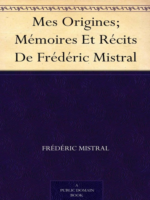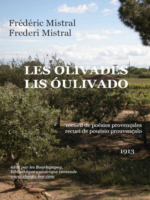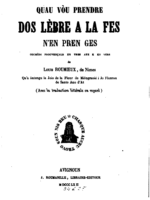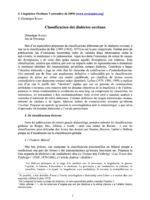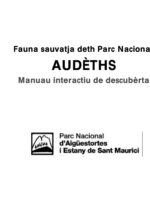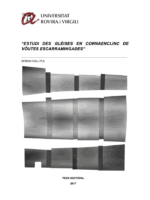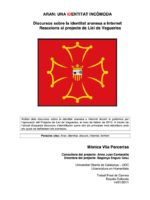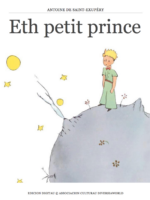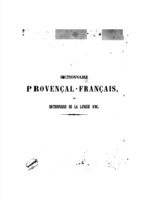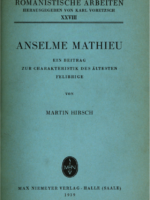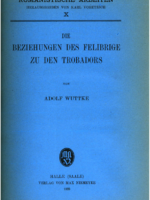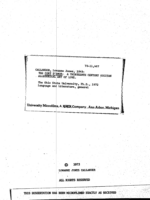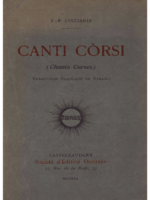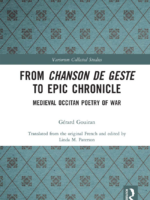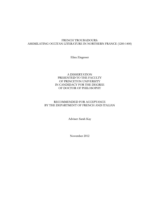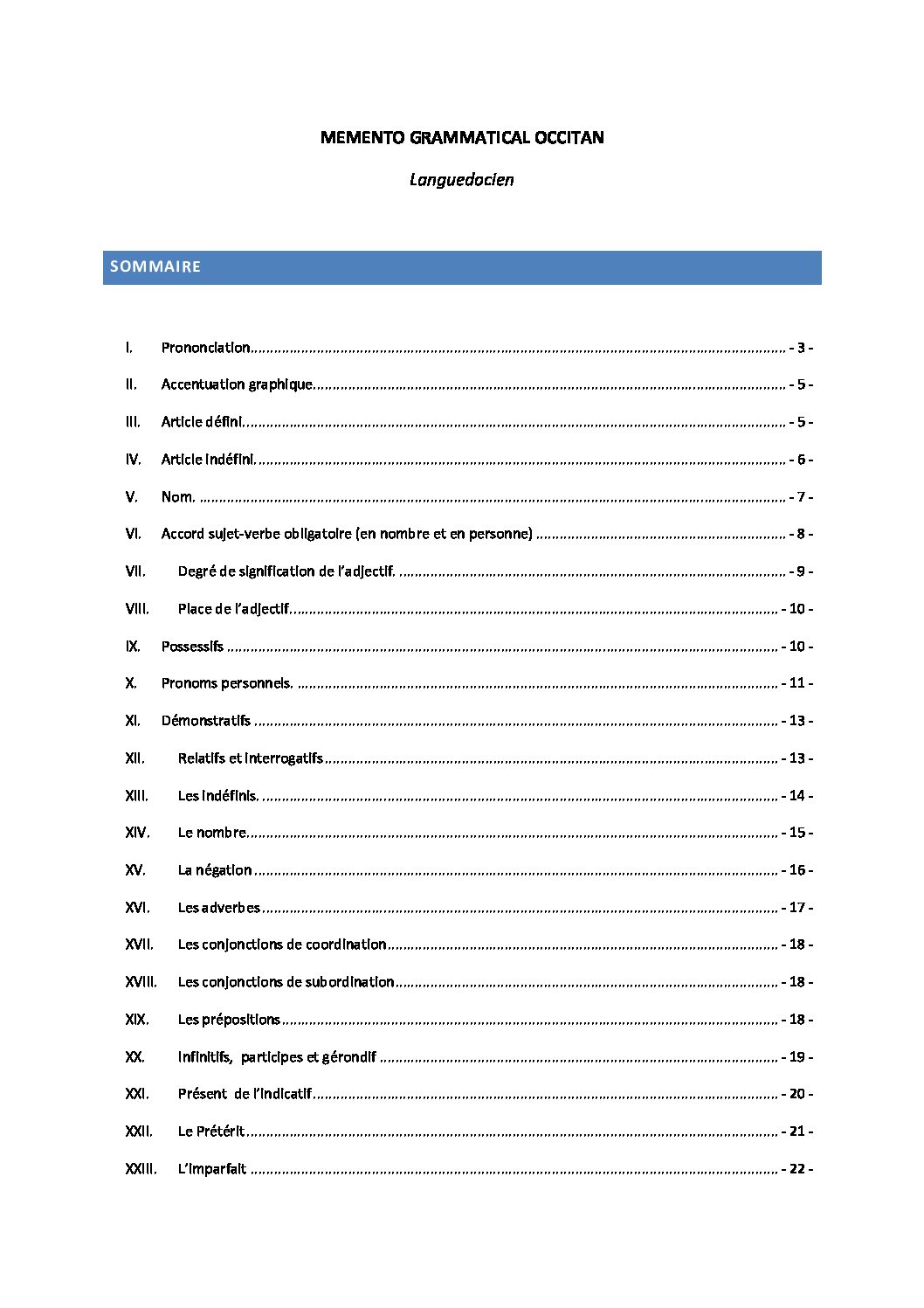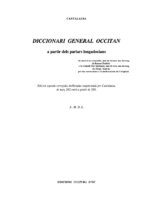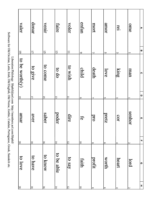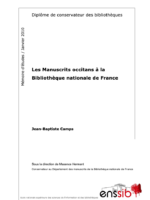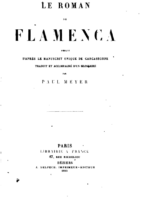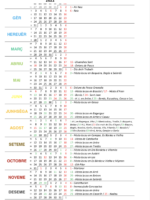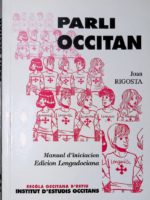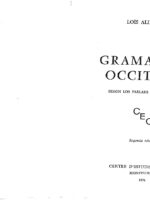Recommended Books
-
Classificacion dei dialèctes occitans
0,00 €Mai d’un especialista prepausan de classificacions diferentas per lei dialèctes occitans, e mai se la classificacion de Bèc (1995 [1963], 1973) es uei la pus vulgarizada. Tanben pron de publicacions fan d’omissions recurrentas subre de varietats fòrça interessantas coma lo sud-vivarés, lo mentonasc o lo judeooccitan. Aquò nos dona l’escasença de cercar lei causas dei divergéncias e de veire dins quina mesura aquelei divergéncias son relativas. Tota classificacion, relativa que relativa, pòt aver un impacte subre lei representacions e dramatizar lo sentiment identitari dei renaissentistas qu’utilizan certanei dialèctes. Contribuís a fargar l’identitat dialectala e jòga un ròtle dins lei chausidas de codificacion e d’estandardizacion. Aicí pretendi pas de fixar una arquitectura definitiva e indiscutibla per la classificacion: prepausi de pistas per trobar una sintèsi equilibrada, per clarificar de tèrmes sovent contradictòris e per desmontar certanei mites identitaris. Lafont (1979, 1996, 1999) a explicat mai d’un còp lo perilh deis “identitats” rigidas que son en generau de construccions artificialas e recentas, sens relacion amb lei donadas objectivas de la lingüistica e de l’istòria; pasmens lo mitan renaissentista (o occitanista au sens larg, en comprenent lei classicistas, lei mistralencs, lei bonaudians e leis escòladaupoïstas) rèsta sovent sord a aqueleis analisis e contunha d’entretenir de mites dialectaus. Certanei defensors dei lengas minorizadas vesinas, subretot de catalans e de ligurs, fabrican tanben de construccions erronèas qu’afèctan l’occitan. Prepausi un apròchi qu’assòcia la sociolingüistica amb la dialectologia1 e que cèrca d’apreendre lei donadas dialectalas a l’escala panoccitana.
-
Fauna sauvatja deth Parc Nacionau: audèths
0,00 €Un des objectius basics deth Parc ei apregondir ena coneishença e ena recèrca deth sòn patri- mòni viu, entà poder-lo gestionar e divulgar de manèra fòrça mès suenhada e eficaça.
En aguest sens, non hè guairi ans que se hec un esfòrç important de prospeccion, e actualiza- cion de donades sus es audèths deth Parc e era Zòna Periferica. Es resultats se concretèren en Atles dels ocells nidificants del Parc Nacional i el seu entorn, publicat en 2005, en coïncidén- cia damb eth 50au aniversari deth Parc Nacionau. Era òbra da continuitat e precision as dona- des obtengudes per auança ena zòna, entara elaboracion dera segona edicion der Atles dels ocells de Catalunya.
Er atles deth Parc recuelh era preséncia entre es sòns limits, es dera Zòna Periferica, e es dera zòna d’influéncia considerada, de 121 espècies nidificantes —er estatus e distribucion des quaus se descriu e precise— e des 24 mès de migrantes o estivaus. Tanben se i analise era evolucion des espècies damb era perspectiva des ans, tient en compde era situacion detectada hè 20 ans en prumèr atlas catalan e, se tracten, tanben, es donades provenentes der esfòrç de seguiment especific que ja hè ans que se hè as espècies de mès valor. Era òbra qu’auetz enes mans se documente fidèlament en aguest trabalh e ne hè ua projeccion divulgativa. A partir des sues dona- des e conclusions descriu, de manèra sintetica e grafica, es 54 espècies mès comunes o signi- ficatives dera zòna.Era intencion non ei pas auferir ua informacion exaustiva —que ja l’auferís er atlas— senon convi – dar ara descubèrta des audèths a totes aqueres persones que poguen auer un shinhau de curio- sitat, maugrat que non siguen pas especialistes ena matèria. Per açò s’a hèt ua triga des espè- cies que representen era immensa majoria des possibles observacions en Parc e auferir es recor- si e orientacions qu’estimulen e faciliten ua bona experiéncia d’aproximacion as audèths sus eth terren.
-
Estudi des glèises en cornaenclinc de vòutes escarramingades
0,00 €Era Val d’Aran se place ena cara Nord des Pirenèus. Es sues caracteristiques geografiques e climatiques, atau coma era sua orientacion cap ar Atlantic an condicionat ath long dera istoria toti es factors dera societat entre eri era arquitectura e era construccion. Aguest ei un des principaus motius entà qu’era sua arquitectura age agut ua difusion escassa. Siguec a compdar deth torisme pirenenc provinent de França que siguec coneishuda. Violet le Duc, Elies Rogent, Puig i Cadafalch, Domenech i Monater e Basegoda Nonell son autors que posterioramente realizen aportacions scientifiques subergessentes.
Era presenta investigacion se plantege en contèxte dera assignatura de Construccion VI dera Escola d’Arquitectura de Reus dera Universitat Rovira i Virgili. Es trabalhs practics des alumnes suscitèren er interès ena generacion dera informacion damb metodes de captura massiva de donades coma er escanèr lasèr. Es campanhes d’escaneg lasèr se realizen en totes es glèises dera Val d’Aran, en tot hèr-ne un totau de 43 e sonque se prescindís der escaneg dera glèisa de Baqueira e dera glèisa consagrada de Mijaran. Autant ua coma era auta son de recenta construccion.
Aguesta Tèsi Doctorau se centre en estudi des glèises deth prumèr romanic segontes era classificacion d’Emmanuel Garland. Ei vertat qu’autors coma Puig i Cadafalch heren a conéisher e descriueren quauques glèises, principaument es glèises basilicaus. Ua des caracteristiques mès importantes dera arquitectura romanica ei er us de voutes. Puig i Cadafalch e Basegoda Nonell sagèren d’explicar era sua origina e forma.
Un prumèr objectiu ei eth de generar ua documentacion planimetrica, realizada a compdar de bromes de punts que complemente era ja realizada per Domenech i Montaner, Puig i Cadafalch e Bassegoda Nonell.
Un dusau objectiu consistís en estudi des construcciones prescientifiques. Aguestes plantegen un especiau interès entà determinar quines son es principis en qué se basauen es constructors des edificis romanics. Es obres de fabrica dera Val son absoludament deformables e formarien part d’aguest grop de construcciones damb aguesta fenomenologia caracteristica. Es glèises romaniques dera Val d’Aran son un conjunt unitari d’edificis qu’an estat poc alteradi ath long dera istoria.
Es resultats mostren dues tipologies d’edificis qu’atien a principis geometrics e d’estabilitat plan diferenti. Tanben mostre era viabilitat deth metode seguit entar estudi des assetaments e esbauçaments en tot èster d’utilitat tanben entà cimentar es bases entà obtier critèris de simplificacion que permeterà estudis damb elements finits. -
Aran: una identitat incòmoda
0,00 €Anàlisi dels discursos sobre la identitat aranesa a Internet durant la polèmica per l’aprovació del Projecte de Llei de Vegueries, el mes de febrer de 2010. A través de l’estudi d’aquests discursos s’identifiquen quins són els principals trets identitaris amb els quals es defineixen els aranesos.
-
-
The “Cort d’Amor”: A Thirteenth Century Occitan Allegorical Art of Love
0,00 €With the exception of the romance of Flamenca, and to a lesser extent, the Arthurian romance of Jaufre. the medieval Occitan narrative poems of the thirteenth century have attracted very little scholarly attention, and among the shorter novas, only one, the Castla-gllos by Raimon Vidal, has been published recently. No full length study of Occitan allegory has yet appeared, al though one scholar,. Marc-RenS Jung, did devote one chap te r to th is topic in a broad survey of the medieval allegorical poem: Etudes sur le poeme allégorlque en France au rao.yen age. Unfortunately, nearly all studies of medieval allegory that have appeared In the last two decades take one or another of the great epic allegories like The Romance of the Rose. The Divine Comedy, or The Canterbury Tales, as. either point of departure or point of arrival, and as a result, the ensuing source studies or definitions are inevitably distorted by the magnetic field that such masterpieces ordinarily deploy. This tendency is particularly disappointing (in view of the fact that the Occitan allegories are, for the most part, earlier than the Romance of the Rose of Guillaume de Lorris, the first of these epic allegories. For this reason, if for no other, they deserve to be considered for and .by themselves.
-
From Chanson de Geste to Epic Chronicle: Medieval Occitan Poetry of War
0,00 €In this collection of essays Gérard Gouiran, one of the world’s leading and much- loved scholars of medieval Occitan literature, examines this literature from a primarily historical perspective. Through texts offering hitherto unexplored insights into the history and culture of medieval Europe, he studies topics such as the representation of alterity through female figures and Saracens in opposition to the ideal of the Christian knight; the ways in which the narrating of history can become resistance and propaganda discourse in the clash between the Catholic Church and the French on the one hand and the Cathar heretics and the people of Occitania on the other; questions of intertextuality and intercultural relations; cultural representations fashioning the West in contact with the East; and Christian dissidence in the twelfth and thirteenth centuries. Written in an approachable style, the book will be of historical, literary and philological interest to scholars and students, as well as any reader curious about this hitherto little-known Occitan literature.
Gérard Gouiran was born in 1945 at Le Rove, which was then a small village close to Marseille. His parents often spoke Occitan between themselves but avoided doing so with their children for fear of damaging their education. It was only after studying classics in Marseille and then Paris that Professor Gouiran rediscovered the Occitan language, and from then on he has devoted himself to medieval literature. Best known for his magisterial edition of the troubadour Bertran de Born, he has written – and spoken – widely on troubadour lyric, epic and romance.
Linda M. Paterson taught at Northeastern University, Boston, USA, for two years before moving to the University of Warwick, UK, in 1971, where she is now Professor Emerita. Her books include Troubadours and Eloquence (1975); The World of the Troubadours: Medieval Occitan Society, c.1100–c.1250 (1993); Culture and Society in Medieval Occitania (2011); and Singing the Crusades: French and Occitan Lyric Responses to the Crusading Movement, 1137–1336 (2018).
-
French troubadours: assimilating Occitan literature in northern France (1200-1400)
0,00 €French Troubadours explores the reception of Occitan lyric in France in the thirteenth and fourteenth centuries, that is, in the period corresponding to the Albigensian Crusade (1209–1229) and its aftermath, which witnessed France’s annexation of the majority of Occitania. Surveying the corpus of French romances that quote Occitan song (Part I) and French songbooks that also contain Occitan lyrics (Part II), it shows how Occitan poems–from the very beginning of their French reception–were subtly incorporated into the French canon by way of imitation, compilation with French texts, and adaptation to the French sound system.
Chapter 1, on Jean Renart’s Roman de la rose, shows how the troubadours are collapsed into a set of francophone lyrics, which are enjoyed not in France but by the Holy Roman Emperor. French-language lyric, and other forms of French culture, are presented as the degre zero of culture in the German Empire, while Germanic languages are treated as foreign. In Chapter 2, I turn to Gerbert de Montreuil’s Roman de la violette, which, like Renart’s Rose, appropriates troubadour lyrics linguistically, and–in one instance–also associates them with the Holy Roman Empire. Here, however, the Holy Roman Empire is not a neutral cadre, but a negative space. Chapter 3, devoted to Richard de Fournival’s Bestiaire d’amour, shows how Richard obscures the first-person language and rhyme of the troubadour poems he quotes.
In Part II, I turn to the set of French songbooks that transmit Occitan lyric. A study of compilation patterns reveals that, rather than being transmitted in a separate section of songbooks, Occitan poems–which are often Gallicized–are almost always interspersed with French lyrics. Consequently, a medieval reader who encountered the troubadours only in French transmission would have little chance of recognizing their cultural specificity. In Chapter 5, I explore the “pseudo-Occitan” corpus, which comprises pieces that contain Occitan phonological coloring but were probably composed by francophones. I show that these pieces occur primarily in a lower register. This trend fictionally repositions Occitan lyric as both “primitive” and–by extension–as anterior to French lyric.
-
Mémento grammatical de l’occitan languedocien
0,00 €Ce guide, conçu par Florian Vernet est une première approche que vous pourrez compléter par la lecture de son livre Dictionnaire grammatical de l’occitan languedocien, disponible aux Presses Universitaires de la Méditerranée.
-
Diccionari General Occitan Cantalausa
0,00 €A partir dels parlars lengadocians de mercé los conselhs, mai de trenta ans dereng de Ramon Chatbèrt e lo trabalh fòrt minimós, mai de tres ans dereng, de Sèrgi Gairal, per las correccions e la melhoracion de l’original.Es per aquò qu’es un Diccionari General, un diccionari de l’occitan larg, que fòrça tèrmes, scientifics o pas, son tan provençals, gascons, lemosins, bearneses o auvernhasses. coma lengadocians. Pus precisament, per aiceste parlar, Cantalausa a ensajat de restablir las formas o las accepcions pus etimologicas, e mai se l’evolucion semantica d’una lenga es un fenomèn natural, que los òmes e las societats càmbian.
-
Old Occitan Flash Cards
0,00 €Liberation Philology libphil@aol.com.
Software for Icelandic, Norwegian, Danish, Swedish, Finnish, Old Norse, Gothic, Latin, Old English , Greek, Sanskrit etc. -
Les manuscrits occitans à la Bibliothèque nationale de France
0,00 €La Bibliothèque nationale de France conserve, pour le domaine de la littérature oc- citane du Moyen Âge, la plus vaste collection de manuscrits au niveau mondial. Pourtant, en dépit de son extraordinaire richesse, cette collection n’a qu’assez rarement été prise en compte en tant que telle et, quoique très étudiée par les chercheurs, demeure à certains égards méconnue. Une cause probable en est le fait que les manuscrits occitans, cotés en Français ou en Latin, ne constituent pas un fonds cohérent à l’origine unique, mais ont été acquis en divers lieux et en divers temps, sans faire l’objet d’une cotation propre. Ce mémoire se donne pour ambition de fournir un outil de connaissance de cette collection, qui soit profitable aux démarches de valorisation et de conservation le concernant.

